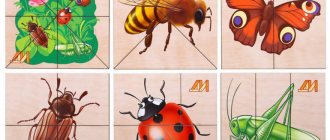TRIZ technologies in kindergarten according to the Federal State Educational Standard have not yet been sufficiently developed, and teachers who want to modernize their work and make it more productive with the help of new techniques have a wide field of activity open.
A game based on TRIZ technology for preschoolers is structured in such a way that all possible functions of the child’s brain, and that of an adult too, are included in the work. Practice shows that TRIZ problems for children with or without answers are solved by adults with great pleasure. This is because these are not ordinary tasks with a standard set of rules and algorithms. Quite often this is a solution to life situations from the opposite angle.
This approach allows you to adapt training to everyday conditions, and apply the acquired knowledge in life. Unfortunately, traditional education does not promise such prospects.
Altshuller's TRIZ technology method includes a unique approach to solving any given problem, be it an educational or everyday situation. Children are unobtrusively taught to think, look for options, opportunities. The guys do not act according to a previously prepared template; each new task is always impromptu. Moreover, TRIZ games for preschoolers in preschool educational institutions show participants in the process that there are no wrong answers, there are only unfinished ones that have not been brought to the IFR (ideal final result). This means that the child is not mistaken, he just needs to complete the solution.
But let's move on to the games from the TRIZ card index. In general, in theory, there are a huge number of games for children and adults. TRIZ is generally notable for the fact that it absorbs everything important and useful that can in any way affect the development of brain activity. We will look at several popular and quite effective techniques.
Article: “Consultation for parents “TRIZ games for parents””
Municipal autonomous preschool educational institution
"Kindergarten No. 92 of a general developmental type"
Consultation for parents “TRIZ games for parents”
Performed:
Titova Svetlana
Vasilevna
2021
The TRIZ methodology was developed by the science fiction writer G. S. Altshuller. At first, this technique was not in demand because it was not understood, but it seemed very interesting. The technique was forgotten for a long time, because the methods of this technology were new and unconventional. And only in 1987 they began to use it in kindergarten. Currently, TRIZ (the theory of solving inventive problems) occupies one of the main places in the development of preschool children. After all, TRIZ, on the one hand, is an entertaining game, on the other hand, it is the development of mental activity through creativity. TRIZ promotes the development of analytical skills; teaches the child to reason and defend his point of view; helps the child cope with natural shyness and reticence; cultivates the desire to learn and receive new information; gives freedom of speech and freedom of expression of personality; the child becomes more versatile, that is, coping with easy tasks to begin with, he gradually learns to find a way out of more complex situations, which will undoubtedly be useful to him in adulthood.
TRIZ technology didactic games can be used not only in kindergarten, but also at home. An eternal problem that parents have is what to do with their child at home on weekends and in the evening. An assistant in solving this problem can be TRIZ didactic games, which will allow you to pass the time and spend it interestingly.
All parents read fairy tales to their children. After reading a fairy tale, you can ask your child to fantasize. Ask if he liked the fairy tale, and the end of the fairy tale. Many fairy tales don't end well. Invite your child to come up with a new ending to the fairy tale, first together with him, and then let the child develop his imagination himself. We are sure that this activity will bring pleasure to parents and baby. Help your child to fantasize for the first time, don’t say to him: this doesn’t happen, it shouldn’t happen this way. Adhere to the TRIZ motto “You can say anything!” And the children talk and invent. Listen carefully to your baby. In kindergarten, the teacher listens to each child. Let your children learn to object to you, their parents, the teacher and each other, but with reason, offering something in return or proving something. Remember, children should only be given positive feedback: “interesting”, “unusual”, “curious”, “good”, “well done”, etc.
Many parents have children with a sweet tooth, use the “Good - Bad” game. By playing this game, your child will learn to identify positive and negative aspects in objects and objects in the surrounding world. The most common example: Eating candy is good. Why? Eating candy is bad. Why? I think that even a three-year-old child will give you a lot of reasons.
To develop your children’s logical thinking, use the “Fantasy” game, which can be used not only when reading fairy tales, but also in other life situations. This game helps you find new resources for solving these problems. A common life situation: your child does not want to collect toys. Using various tricks, you manage to persuade the baby to put the toys in their places. Sit comfortably on the sofa and invite your child to imagine that all the toys were offended and left him. What will happen then? The baby will think, invent and at the same time develop his speech. If you have a daughter, ask her to think and tell her what can replace lost hairpins. I'm sure she will come up with many options.
Many families love to do puzzles. Diversify this activity, use the TRIZ technology game “Something is part of something”, which will help develop perseverance in your child, which is very important in our time of hyperactive children, imagination, visual memory, and logical thinking.
As you and I know, play in preschool age is the main activity. And during play, the preschooler develops social and personal relationships.
If we set ourselves the goal of developing a child, then we must take into account that each child has his own interests, abilities and inclinations, and different children have different levels of development. Didactic games using the TRIZ method help preschoolers develop mental abilities, coherent speech, logical thinking, imagination, memory, attention, and perseverance. They help withdrawn and shy children to become more relaxed and sociable. They make each child individual. He is not afraid to speak his mind. He tries to defend his point of view, which will certainly be useful to him in adult life.
Card index of games using TRIZ technology in the middle group of preschool educational institutions
Nursina Karamurzina Card index of games using TRIZ technology in the middle group of preschool educational institutions
Game “Tree, Bird, Insect, Wild Animal”
Goal: to develop the ability to classify objects of living nature.
Rules: the adult says: “Tree” (The child names any tree). "Bird. Insect. Wild animal”, etc. in a circle. The name of the game can be changed. For example, “Fish, birds, animals”, “Trees, flowers, insects”.
Game “What (who) was, what (who) became”
Goal: to develop the ability to determine the line of development of an object.
Rules: an adult names any object of living nature. Children say what (who) he was
what (who) has become. For example, a chicken was an egg, but became a hen or a rooster. There was cabbage
a seed, became a salad.
Game “Was. Eat. Will"
Purpose: to train children in determining the properties of an object in the past, present and future.
Rules: an adult names an object of living nature. The child lists its properties in the past, present and future. For example: The cucumber was small, green, prickly, bitter; now – big, green, sweet, juicy; It will be salty, soft, crispy.
Game "Who Lives Where"
Goal: to teach children to establish what a given object is a part of.
Rules: an adult names an object of living nature. Children name the habitat of these objects. You can use pictures . For example, a bear. Habitat : forest, zoo, cartoon, book, candy wrapper.
Game "I'll take you with me"
Goal: to teach children to establish a connection between the habitat and an object of wildlife.
Rules: an adult names the habitat and offers to take with them the objects of wildlife that are located there.
For example, I am a river and I will take with me all living things that are in the river.
Game “You are a part of me”
Goal: to develop the ability to classify objects of living nature.
Rules: the adult names the image, and the child names its parts. For example: “I am a tree, you are my piece. Who are you?"; “I am a daisy, you are a piece of me. Who are you?"; “I am an orange, you are a part of me. Who are you?"; “I am a mushroom, you are a part of me. Who are you?"; “I am a spikelet, you are a piece of me. Who are you?"
Game "Who am I?"
Goal: to develop the ability to name as many living objects as possible one part at a time
nature.
Rules: an adult names one part. Children - as many objects as possible that have this part. “I have a piece of paper. Who am I?" (tree, bush, flower); “I have a button. What am I?"; “I have a nose. Who am I?"; “I have a tail. Who am I?"
Game "What does it look like"
Goal: to develop associative thinking, teach children to compare systems.
Rules: an adult names an object, and children name objects similar to it. For example, what does a flower look like? (by color, shape, function, past, future).
"Magic wand"
TRIZ has techniques that help you fantasize and find interesting ideas. One of them is increase and decrease. Its essence is that you need to mentally imagine how an object either begins to become larger and larger or, on the contrary, decreases. And for this you can come up with a magic wand!
Tell your child: “I have a pencil, let’s pretend it turns into a magic wand. Now he can increase or decrease whatever you want. What would you like to increase or decrease?"
Possible answers:
- I want to reduce winter and increase summer.
- I want to extend my weekend.
- I want to enlarge raindrops to the size of a watermelon.
Now let’s complicate this game with additional questions: “Why increase or decrease this?”
- I want to enlarge the candy to the size of a refrigerator so that I can cut off pieces with a knife.
- Let your arms temporarily become so long that you can take an apple from a branch, say hello to a friend through a window, or get a ball from the roof.
Then discuss what is good and convenient about these ideas and what is bad. Instead of a pencil, you can use any wand, let it become magical!
"Good bad"
Being able to find and identify contradictions is an important skill that makes up TRIZ thinking , because it is with the resolution of contradictions that the invention and creation of something new begins.
The first participant names a phenomenon or event and says why it is good, the next one continues, but explains in what cases it can be bad, after which the first one begins to talk about the good aspects of the last statement. For example, the parent begins: “Going for a walk is good, because you can find something interesting.” The child continues: “Finding something interesting is bad, because you can’t bring it home from the street.” The next one says: “If anything “You can’t bring something interesting home from the street - that’s good, because then you can find something interesting at home,” and so on.
"Bag of Treasures"
One of the important components of TRIZ thinking is the systematic ability to see an object in all its interconnections, which means its past, present and future. This game will teach you to understand objects in the present, to realize why they are created, what they are made of, and what type they belong to. Place a number of objects or toys in a bag made of opaque material. Let the child put his hand into the bag and, feeling the object, list out loud the properties that tactile sensations tell him.
It is advisable to take no more than 56 objects at a time, made from different materials and not having clearly defined parts; it happens that instead of properties, the child names parts, and the answer becomes obvious.
Once the properties are identified and listed, ask them to think about what the item is like. For example, you have soap in your bag, it is slippery and cold. What else is the same? You can come up with your own combinations, and to spice up the game, you can ask your child to find an object at home with a hidden property (wet, heavy, rough, etc.).
“Not yes, but no!”
The need to switch from one way of working to another, from one activity to another, makes the child’s thinking dynamic, flexible, capable of coping with non-standard, unexpected tasks, and develops his creative thinking. The game “Not yes, but no!” is great for this. In it you need to answer questions that usually imply a positive answer, or a negative one:
- Will a car always overtake a pedestrian? No, if a car is stopped at a traffic light, a pedestrian will easily overtake it!
- Is it always light during the day? No, if the weather is bad and there are clouds in the sky, then even during the day there will be twilight.
- Do all trees have leaves? No, the Christmas tree has needles.
Try to ask your child such questions and reason with him, and if the child is still small, tell him how differently the world around him works and pay attention to interesting things.
"Make a riddle"
Choose any object about which you want to write a riddle, determine what this object is and what is in the world that is similar to it. For example, if you chose “igloo” as an object, then to the questions: “What object? What does it look like?”, you will answer: “Sharp, like an arrow, shiny, like a Christmas tree decoration, slippery, like a fish.”
Now we combine all the words with the expression “but not” and get a riddle: “Sharp, but not an arrow, shiny, but not a Christmas tree toy, slippery, but not a fish. What it is?" Try composing such a riddle with your child!
“What then?”
This game can gradually become more difficult depending on the age of the child. You name the initial phenomenon, and the next player needs to continue the chain of sequence in the correct order.
- First autumn, and then? - Winter, and then? - Spring, and then? - Summer.
- First Tuesday, and then? - Wednesday .
- First evening, and then? - Night.
- First breakfast, and then? - Dinner.
With older children you can use more complex concepts:
- First clay, and then? — Vase, brick, sculpture.
- First the log, and then? - House, paper, closet.
- First milk, and then? - Porridge, cocoa, butter, sour cream.
- First the berries, and then? - Compote, preserves, jam, jelly.
Didactic games with elements of TRIZ technology
Svetlana Moiseeva
Didactic games with elements of TRIZ technology
1. Didactic games with elements of TRIZ technology
“ Games based on plot paintings, landscapes, still lifes”
.
Purpose of the game : develop the ability to find an object in a picture; determine the location of the object in the picture; develop the ability to find relationships between objects in a picture; use descriptions of possible sensations using different senses; description of an object, changing it over time.
Didactic material : pictures of plots, landscapes, still life, cards with analysis of the second sense organs.
Game description :
Subject, landscape, and still life pictures are shown. Children take turns finding an object in the picture, determining the location of the object in the picture, finding the relationship between them, changing them by time, and using different senses to describe their sensations.
2. Didactic game with elements of TRIZ technology (morphological table)
"In the world of professions"
.
Purpose of the game :
Consolidate and systematize children’s knowledge about professions;
Develop the ability to draw conclusions and conclusions;
Strengthen the ability to use different types of sentences in speech (independently and with the help of an adult)
.
Develop communication skills - the ability to work in pairs and teams, the ability to collectively discuss a common problem, improve the ability to reflect on one’s activities.
Development of the ability to make independent conclusions based on the ability to perform operations of synthesis, analysis, and generalization.
Development of a child’s personal qualities: emotional responsiveness, curiosity, independence, creative activity.
Didactic material : morphological table, cards with names, characteristics, professions of people, a set of pictures for the game.
Description of the game : the game consists of a morphological table - pictures of people's professions are located vertically, names of characteristics are located horizontally. The teacher invites the children to look at the table and name everything they see on it. In front of the children there are cards depicting signs of professions; you need to find the corresponding sign of an object. For example: a child selects any card with a sign of an object and finds the corresponding object of this sign, analyzes the task vertically, horizontally, parts, which means the task is to find body parts among all the pictures that belong to this object.
3. Didactic game with elements of TRIZ technology : “Safety on the street, at home, on the water, on vacation. ” (puzzles)
Purpose of the game : develop the ability to find the causes and effects that occur depending on the conditions. The same cause under different conditions causes different consequences.
Objectives: Formation of a holistic picture of the world, development of logical thinking, formation of ideas about the interrelations of objects, phenomena and events of the surrounding world, development of skills to predict events, development of communication skills.
Didactic material : cards depicting the cause of an accident, what can happen during a vacation, when a child is left at home alone, swimming in the river, and the consequences as a result.
Game description : The teacher invites the children to assemble puzzles. Shows a card depicting the cause of an accident, which can happen during a vacation, when a child is left at home alone, swimming in the river, and the children must pick up cards depicting the consequences of safety on the street, at home, on the water, on vacation.
4. Didactic game with elements of TRIZ technology:
Ecological lotto: “I follow traffic rules”
Purpose of the game : develop the ability to find prohibiting and permissive traffic signs, establish cause-and-effect relationships between them.
Objectives: Development of logical thinking, formation of ideas about the interrelations of objects, phenomena and events of the surrounding world, development of skills to predict events, development of communication skills.
Didactic material : environmental lotto, cards depicting traffic rules, traffic rules compliance card, traffic rules non-compliance card.
Description of the game : The teacher invites the children to play an environmental lotto called: “I follow traffic rules.” Shows the main reason (for example, a card depicting compliance with traffic regulations is green, and children need to find the ensuing consequences. And vice versa, a card depicting non-compliance with traffic regulations is red, and the ensuing consequences.




